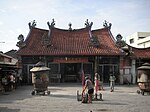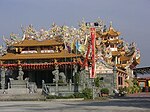Penangite Chinese
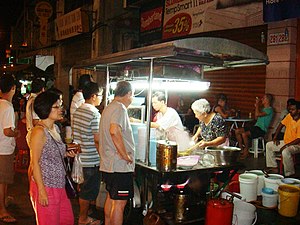 A Chinese wanton mee hawker stall in George Town. | |
| Total population | |
| 694,200 42.35% of Penang's total population in 2017[1] | |
| Regions with significant populations | |
Penang Island : George Town, Bayan Lepas Seberang Perai : Butterworth, Bukit Mertajam, Nibong Tebal, Batu Kawan | |
| Languages | |
| Penang Hokkien (lingua franca) Mandarin, Malaysian (national language), English, Manglish (creole) Other dialects : Cantonese, Teochew, Hakka | |
| Religion | |
| Predominantly Buddhism and/or Taoism, with a significant number of Christians. Minority : Islam, Atheism | |
| Related ethnic groups | |
| Chinese diaspora, Peranakan, Chindian |
Penangite Chinese are ethnic Chinese Malaysians of full or partial Chinese ancestry who either hail from or live within the State of Penang. As of 2017[update], nearly 42% of Penang's population belonged to the Chinese ethnic group, making ethnic Chinese the largest ethnic community within the state.[1][2]
Most Chinese Penangites are the descendants of Chinese colonists, traders, accountants, merchants, labourers and immigrants from southern China who moved to the Penang between the 18th and 20th centuries. By the mid-19th century, George Town, the capital city of Penang, was home to a significant Peranakan community, also known as the King's Chinese due to their loyalty to the British crown.[3] Under British colonial rule, Penang continued to experience increasing Chinese immigration throughout the 19th century. As the largest group of Penangite Chinese are ethnic Hokkiens (38% of the Chinese penangite population in 1957)[4][5] who came from southern Fujian Province, home to the Hokkien dialect, Penang Hokkien was gradually developed and is now widely used by Penangites for daily communication.
Penang's Chinese have been well-represented within Malaysia and also internationally in various professional, political, economic and other fields. To date, Penang is the only state in Malaysia where the position of the Chief Minister, who leads the state government, has been continuously held by an ethnic Chinese since independence. Renowned figures, including Jimmy Choo and Nicol David, hailed from Penang and have contributed greatly in raising the country's profile internationally.
In Mandarin, Penangite Chinese clearly distinguish themselves as full Chinese (s 华人, t 華人, p Huárén) rather than overseas Chinese (s 华裔, t 華裔, pin. Huáyì; s 华侨, t 華僑, pin. Huáqiáo). Similarly, Penangite Chinese typically refer to themselves as Tn̂g-lâng in Penang Hokkien.[6] In English parlance within Penang, Penangite Chinese are simply referred to as "Chinese".
History



Chinese sailors had explored the seas off Penang Island as early as the 15th century. During the Ming Dynasty, Chinese seafarers led by Admiral Zheng He sailed the length of the Malacca Straits; Penang Island may have appeared in the Nautical Charts of Zheng He.
However, it was only sometime in the 18th century when the Chinese began to arrive on Penang Island. It was recorded that the fishing village of Tanjung Tokong on the northern coast of the island was founded by Zhang Li, a sailor whose arrival on Penang Island preceded that of Captain Francis Light by at least a few decades.[7][8]
After the British East India Company under Captain Francis Light founded George Town in 1786, ethnic Chinese began to move to Penang in increasing numbers. In particular, the Peranakans, who already had established themselves along the western coast of the Malay Peninsula, shifted to Penang.[9] This, coupled with the greater number of newer immigrants from China throughout the 19th century, effectively made the Chinese the largest ethnic group in Penang by the 1850s.[10]

As Penang grew into a major entrepôt towards the end of the 19th century, the influx of various cultures and religions would create a melting pot where the multi-ethnic and multi-religious society could exist in harmony. Similarly, over time, the newer Chinese arrivals became acculturated to the existing local culture and customs due to intermarriages between the Peranakans and the "Sinkeh". At the turn of the century, the Chinese nationalist Sun Yat-sen's campaigns to liberate China from imperial Manchu rule attracted considerable financial support from Penang's Chinese population.
During World War II, ethnic Chinese in Penang suffered brutal and often violent treatment in the hands of the occupying Imperial Japanese Army. The Japanese implemented a policy known as Sook Ching, a systematic purge of perceived hostile elements, including the Chinese. Hundreds of ethnic Chinese as well as 3,500 other non-Chinese POWs were massacred and buried in unmarked mass graves throughout Penang during the Japanese occupation period.[11]
Demographics
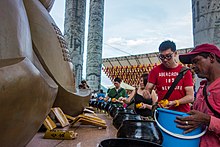
Out of the nearly 700,000 Penangite Chinese, most are concentrated on Penang Island, particularly within and around the city of George Town.
Ethnic Chinese constitute the plurality of Penang Island's population; the 2010 Malaysian Census indicated that about 53% of Penang Island's inhabitants were of Chinese descent.[12] On the island, more Chinese reside within the Northeastern District, where George Town is situated, compared to the less-populated Southwestern District.[13]
The Chinese also accounted for 34.2% of the population in Seberang Perai, the mainland halve of the State of Penang.[12] They most commonly reside within the Central and Southern districts, forming a visible majority in the towns within these districts, such as Bukit Mertajam, Batu Kawan and Nibong Tebal.[14]
| Area | Percentage (%) | Largest concentrations |
|---|---|---|
| Penang Island | 53.07 | Northeast Penang Island District (George Town) |
| Seberang Perai | 34.21 | Central Seberang Perai District (Bukit Mertajam) |
| South Seberang Perai District (Nibong Tebal, Batu Kawan) |
Language

According to the 2010 Malaysian Census, up to 63.9% of Penang's Chinese population spoke Hokkien as their mother tongue.[15] This figure likely included those with Peranakan ancestry. The second largest Chinese linguistic group in Penang was the Teochews, constituting 17.8% of Penang's Chinese community, followed by the Cantonese at 8.3%. There were also smaller Hakka and Hainanese communities throughout Penang.[15][16]
| Dialect group | Percentage (%) |
|---|---|
| Hokkien | 63.9 |
| Teochew | 17.8 |
| Cantonese | 8.3 |
| Hakka | 5.2 |
| Hainanese | 1.5 |
| Others | 3.2 |
| Total | 100.0 |

The resulting ubiquitous use of Hokkien has made Penang Hokkien the lingua franca among Penangites. Penang Hokkien, which originated from a subdialect of Zhengzhou Hokkien, incorporated several Malay and English terms over the centuries, eventually evolving into a distinct Hokkien dialect used mainly in northern Malaysia. Uniquely for Penang, this localised Hokkien creole is spoken by many Penangites regardless of race for daily communication, so much so that even local police officers also take courses in Penang Hokkien.[17][18][19] More recently, Penang Hokkien has also been popularised in mass media, particularly through books, dictionaries and movies, due in part to the desire to maintain the dialect's relevance in the face of increasing influence of Mandarin and English amongst the younger generations.[20][21]
Besides Penang Hokkien and Mandarin, the latter of which has been used as a medium of instruction in Chinese schools in Penang, Cantonese, Teochew and Hakka are spoken by smaller numbers of Chinese as well. In general, these communities arrived in Penang after the Hokkiens had already established themselves within the colony in the early 19th century. The Cantonese and Hakka communities, in particular, would go on to predominate parts of George Town towards the end of the 19th century, while a significant number of Teochews were also employed in the agricultural industries within the then Province Wellesley (now Seberang Perai).[16] To this day, many of the Teochews continue to reside in the towns of Seberang Perai, such as Butterworth, Bukit Mertajam and Batu Kawan.
In addition, all Penangites are conversant with Malay, the national language of Malaysia, as the language is made compulsory in all schools in Penang. A legacy of British rule is the existence of several English and missionary schools throughout Penang, which also contributes to the relatively high level of English proficiency among Penangites.[22]
Culture
Cuisine

Along with other races, the Chinese have greatly influenced Penang's street cuisine, one of the more famous culinary styles in Southeast Asia. Penang is famous for its variants of Chinese dishes, including char kuey teow, Hokkien mee and chee cheong fun. These are in addition to the famous asam laksa, a local variant of the Peranakan fusion dish, which was ranked 7th in CNN's list of the world's 50 best dishes.[23]
Festivals


Some of the major Chinese cultural celebrations in Penang include the Chinese New Year, Lantern Festival, and Mid-Autumn Festival.
The largest of all is the Chinese New Year, which includes a number of festivities and observances which are unique to Penang. For instance, the Jade Emperor's Birthday, also known colloquially as the "Hokkien New Year", falls on the 8th day of Chinese New Year and is widely observed in Penang.[24] Chinese New Year festivities in Penang also include the traditional lighting up of the iconic Kek Lok Si Temple, a 'fire watching' ceremony in the Snake Temple and open houses by several ornate Chinese clan houses within George Town's UNESCO World Heritage Site.[25]
Wesak Day is celebrated by the Buddhists with a massive procession by Buddhist associations and temples based in Penang, with floats depicting both Mahayana and Theravada strains.[26] The Taoists observe Qing Ming and the Hungry Ghost Festival, both to honour their departed relatives and friends. The Christians, meanwhile, observe Christmas and Easter, with the Catholics also observing the Saint Anne's Novena for 10 days at the St. Anne's Church in Bukit Mertajam.
Chingay performance

Chingay parades were said to have originated in Penang in the early 20th century, before spreading to the rest of Peninsular Malaysia and Singapore.[27] The Penang variant of the Chingay parade includes a giant flag balancing act on one's forehead.
Since the 1950s, an annual Chingay parade has been held within the city of George Town every December, in a bid to retain this unique cultural practice.[28][29][30]
Landmarks
- Traditional Chinese architecture in Penang
-
Tow Boo Kong Temple, Butterworth
Education
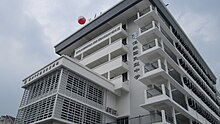
Most Penangite Chinese today either go to a Chinese school, a national school (Sekolah Menengah Kebangsaan, or SMK) or a missionary school. In recent years, international schools, which traditionally cater to Penang's expatriate community, are also increasingly popular among Penangites themselves.[31]
As a result, Penangite Chinese are multilingual, with the ability to converse in Malay, English and either Mandarin or another Chinese dialect (typically the individual's mother tongue). Due to the strong English education system that was established by the British in Penang, many Penangites, especially those who went to missionary schools, are able to maintain at least a reasonable command of English.[22] Mandarin has also been increasingly used by the younger generations, as it is the medium of instruction in Chinese schools throughout the state.
Chinese schools
George Town served as the nucleus of Malaysia's Chinese education system, when in 1904, Chung Hwa Confucian School was established. It was the first Chinese school to be built in British Malaya, as well as the first to use Mandarin as its medium of instruction.
To this day, Chinese schools in Penang maintain a reputation for academic excellence. The Chinese secondary schools in Penang, both public and private, are as listed below.
- Chung Hwa Confucian School, established in 1904, is one of the oldest formal Chinese schools in Southeast Asia. It also became the first to use Mandarin as the medium of instruction instead of other Chinese dialects.
- Chung Ling High School, founded in 1917, was the alma mater of Khaw Boon Wan, Lee Khoon Choy and Koh Tsu Koon.
- Han Chiang High School
- Jit Sin High School
- Penang Chinese Girls' High School
- Union High School
- Convent Datuk Keramat
- Phor Tay High School, established in 1940, was the first Buddhist school in Malaysia.
- Heng Ee High School
- Sacred Heart High School
List of Penangite Chinese


The list includes Penangites of partial Chinese descent.
- Ah Niu (1976- ), singer
- Andrea Fonseka (1984- ), Miss Universe Malaysia 2004
- Chan Peng Soon (1988- ), badminton player and silver medallist in the 2016 Summer Olympics
- Chew Choon Eng (1976- ), badminton player
- Chin Eei Hui (1982- ), badminton player
- Danny Quah (1958- ), economics professor at the National University of Singapore
- David E. L. Choong (1929-2011), badminton player
- Eddy Choong (1930-2013), badminton player
- Chung Keng Quee (1821-1901), founder of Taiping; his mansion is now the Pinang Peranakan Mansion
- Chung Thye Phin (1879-1935), tin and rubber tycoon
- Gu Hongming (1857-1928), writer
- Heah Hock Aun (1932- ), badminton player
- Heah Joo Seang (1899-1962), politician and business leader
- Jimmy Choo (1948- ), world-renowned shoe designer
- Khaw Boon Wan (1952-), Singapore's Coordinating Minister for Infrastructure and Minister for Transport (2015- )
- Koh Lay Huan (-1826), first Kapitan China of Penang
- Koh Tsu Koon (1949- ), third Chief Minister of Penang (1990-2008)
- Law Choo Kiang (1970- ), Speaker of the Penang State Legislative Assembly (2013- )
- Eva Lee Kwok (1942- ), Canadian businesswoman
- Lim Boon Keng (1868-1957), OBE, Chinese physician
- Lim Chong Eu (1919-2010), second Chief Minister of Penang (1969-1990)
- Lim Khim Wah (1989- ), badminton player
- Pik-Sen Lim (1944- ), British actress
- Loh Boon Siew (1915-1995), first Honda distributor in Malaysia
- Low Wee Wern (1990- ), squash player
- Angie Ng, model
- Chelsia Ng (1981- ), actress
- Irene Ng (1963- ), Singapore's Member of Parliament for Tampines (2001-2015)
- Irene Ng (1974- ), American actress
- Ng Tat Wai (1947- ), badminton player
- Nicol David (1983- ), one of the world's best female squash players of all time
- Ooi Tze Liang (1993- ), diver
- Ong Beng Hee (1980- ), squash player
- Ong Ewe Hock (1972- ), badminton player
- Ong Hock Thye (1908-1977), judge
- Saw Teong Hin (1962- ), director of You Mean the World to Me, the first Penang Hokkien film
- Saw Yi Khy (1986- ), swimmer
- Lyndel Soon (1978- ), Miss Tourism Malaysia 2001
- Hannah Tan (1981- ), actress, singer-songwriter, model and television personality
- Tan Twan Eng (1972- ), novelist
- Tee Jing Yi (1991- ), badminton player
- Wee Chong Jin (1917-2005), first Chief Justice of Singapore (1963-1990)
- Wong Pow Nee (1913-2002), first Chief Minister of Penang (1957-1969)
- Wu Lien-teh (1879-1960), Chinese doctor and a nominee for the Nobel Prize in Medicine 1935
- Yeap Chor Ee (1867-1952), businessman
- Yeohlee Teng, American fashion designer
- Ivan Yuen (1990- ), squash player
See also
References
- ^ a b "Current Population Estimates 2017". Malaysian Department of Statistics: 55. 14 July 2017.
- ^ "Penang – not so Chinese after all". Free Malaysia Today. 2011-06-10. Retrieved 2016-12-31.
- ^ Singapore, National Library Board. "Peranakan (Straits Chinese) community | Infopedia". eresources.nlb.gov.sg. Retrieved 2016-12-31.
- ^ Koh Aun Qi (9 September 2017). "Penang Hokkien and its struggle for survival".
- ^ "The process and effects of demographic transition in Penang, Malaysia". January 2013.
- ^ Johny Chee (2008). A Tapestry of Baba Poetry. Areca Books. ISBN 9789834291211.
- ^ "Tanjung Tokong | Property For Sale In Penang Island - The Edge Property Malaysia". news.theedgeproperty.com.my. Retrieved 2017-05-16.
- ^ "A peek into Hakka heritage - Community | The Star Online". www.thestar.com.my. Retrieved 2017-05-16.
- ^ "A Straits-born people and language | Unravel Magazine". Unravel. Retrieved 2016-12-31.
- ^ Usman Haji Yaakob; Nik Norliati Fitri Md Nor (2013). "The Process and Effects of Demographic Transition in Penang, Malaysia" (PDF). School of Humanities. University of Science, Malaysia. pp. 42, 45 6, 9/28. Archived from the original (PDF) on 21 October 2016. Retrieved 25 January 2016.
- ^ Netto, Anil (6 October 2013). "Old Penang: The Sook Ching massacres of World War II - anilnetto.com". anilnetto.com. Retrieved 15 October 2016.
- ^ a b "Key summary statistics for Local Authority areas, Malaysia, 2010" (PDF). Department of Statistics, Malaysia. Archived from the original (PDF) on 5 February 2015. Retrieved 19 June 2013.
- ^ "Latar Belakang". dbd.penang.gov.my (in Malay). Retrieved 2017-05-05.
- ^ "Penang's mainland – Seberang Perai by the numbers". Penang’s mainland – Seberang Perai by the numbers. Retrieved 2017-05-02.
- ^ a b "Dialects and Languages in Numbers". Dialects and Languages in Numbers. Retrieved 2017-05-05.
- ^ a b "Disparate Identities: Penang from a Historical Perspective, 1780–1941" (PDF). Universiti Sains Malaysia. Archived from the original (PDF) on 2017-02-07.
- ^ "Mind your Hokkien - Community | The Star Online". www.thestar.com.my. Retrieved 13 October 2016.
- ^ "Penang Hokkien will be 'dead' in 40 years if people stop using it, says language expert". 2 August 2016. Retrieved 13 October 2016.
- ^ Penang Hokkien Dialect for Penangites & Tourists. George Town, Penang: Areca Books. 2008. ISBN 978-983-40774-3-3.
- ^ "Translating Penang Hokkien to English with ease | theSundaily". www.thesundaily.my. Retrieved 13 October 2016.
- ^ Loh, Arnold. "Shooting to begin for first Penang Hokkien film - Nation | The Star Online". Retrieved 13 October 2016.
- ^ a b http://www.rism.org.my/wp-content/uploads/2015/11/05.-Penang.-The-Next-Metropolis-Dr.-Lim-Kim-Hwa.pdf
- ^ "50 best foods in the world | CNN Travel". Retrieved 18 October 2016.
- ^ "Hokkien New Year (Thni Kong Seh)". www.visitpenang.gov.my. Retrieved 2016-12-31.
- ^ "Chinese New Year in Penang is a Long, Long Party". About.com Travel. Retrieved 2016-12-31.
- ^ II, Administrator. "Wesak Day Celebration 2015". www.visitpenang.gov.my. Retrieved 2016-12-31.
- ^ Singapore, National Library Board,. "Chingay | Infopedia". eresources.nlb.gov.sg. Retrieved 2016-12-31.
{{cite web}}: CS1 maint: extra punctuation (link) CS1 maint: multiple names: authors list (link) - ^ "myPenang". mypenang.gov.my. Retrieved 2017-12-23.
- ^ "A memorable experience for visiting French couple - Nation | The Star Online". www.thestar.com.my. Retrieved 2017-12-23.
- ^ "Parade of stunning stunts - Metro News | The Star Online". www.thestar.com.my. Retrieved 2017-12-23.
- ^ "Private schooling getting popular". Penang Monthly. 2016-01-06. Retrieved 2016-12-31.




